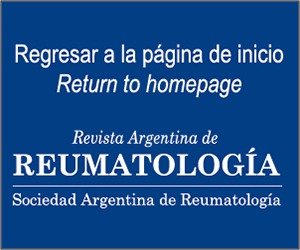Resonancia magnética: su papel actual en las espondiloartritis
Resumen
La Resonancia Magnética (RM) se ha convertido en una herramienta diagnóstica fundamental en la EsP axial, ya que se considera la mejor técnica para la detección de lesiones agudas a nivel del esqueleto axial. Su utilización ha sido la mayor contribución, en los últimos años, en la comprensión del curso de esta enfermedad. Esto ha conducido a que, en los nuevos criterios de la Assessment of SpondyloArthritis International Society (ASAS) para la clasificación de EsP de predominio axial, constituya uno de los brazos de ingreso a los criterios (brazo de imágenes). Además, la cuantificación de inflamación en RM, se ha convertido en uno de los parámetros de desenlace en los ensayos clínicos.Citas
I. D ougados M, Baeten D. Spondyloarthritis. Lancet. 2011;377:2127–37.
II. Z ochling J, Brandt J, Braun J. The current concept of spondyloarthritis with special emphasis on undifferentiated spondyloarthritis. Rheumatology (Oxford). 2005;44:14883–91.
III. van der Linden S, Valkenburg HA, Cats A. Evaluation of diagnostic criteria for ankylosing spondylitis. A proposal for modification of the New York criteria. Arthritis Rheum 1984;27:361–8.
IV. Amor B, Dougados M, Mijiyawa M. Critères de classification des spondylarthropathies. Rev Rheum Mal Ost. 1990;57:85–9.
V. D ougados M, Van der linden SM, Jhulin R, Huitfeldt B, Amor B, Calin A, et al. The European Spondylarthropathy Study Group preliminary criteria for the classification of spondylarthropathy. Arthritis Rheum. 1991;34:1218–27.
VI. Sieper J, Braun J. How important is early therapy in axial spondyloarthritis? Rheum Dis Clin North Am. 2012;38:635–42.
VII. Rudwaleit M, van der Heijde D, Landewé R, Listing J, Akkoc N, Brandt J, et al. The development of Assessment of SpondyloArthritis International Society (ASAS) classification criteria for axial spondyloarthritis (part II): validation and final selection. Ann Rheum Dis. 2009;68:777–83.
VIII. Rudwaleit M, van der Heijde D, Khan MA, Braun J, Sieper J. How to diagnose axial spondyloarthritis early. Ann Rheum Dis 2004;63:535–43.
IX. R udwaleit M, Haibel H, Baraliakos X, Listing J, Märker-Hermann E, Zeidler H, et al. The early disease stage in axial spondylarthritis: results from the German Spondyloarthritis Inception Cohort. Arthritis Rheum 2009;60(3):717-27.
X. Kiltz U, Baraliakos X, Karakostas P, Igelmann M, Kalthoff L, Klink C, et al. Do patients with non-radiographic axial spondylarthritis differ from patients with ankylosing spondylitis? Arthritis Care Res 2012;64(9):1415-22.
XI. Rudwaleit M, Jurik AG, Hermann K-GA, Landewé R, van der Heijde D, Baraliakos X, et al. Defining active sacroiliitis on magnetic resonance imaging (MRI) for classification of axial spondyloarthritis: A consensual approach by the ASAS/ OMERACT MRI group. Ann Rheum Dis. 2009;68:1520-7.
XII. Weber U, Pedersen SJ, Østergaard M, Rufibach K, Lambert RG, Maksymowych WP, et al. Can erosions on MRI of the sacroiliac joints be reliably detected in patients with ankylosing spondylitis? A cross-sectional study. Arthritis Res Ther. 2012;14:R124.
XIII. Sieper J, Rudwaleit M, Baraliakos X, et al: The Assessment of SpondyloArthritis International Society (ASAS) handbook: a guide to assess spondyloarthritis. Ann Rheum Dis. 2009 Jun;68 Suppl 2:ii1-44.
XIV. Hermann K, Baraliakos X, van der Heijde D, et al: Descriptions of spinal MRI lesions and de nition of a positive MRI of the spine in axial spondyloarthritis: a consensual approach by the ASAS/OMERACT MRI study group. Ann Rheum Dis 2012;71:1278–1288.
XV. M andl P, Navarro-Compán V, Terslev L, et al: EULAR recommendations for the use of imaging in the diagnosis and management of spondyloarthritis in clinical practice. Ann Rheum Dis. 2015 Jul;74(7):1327-39.
XVI. S molen JS, Braun J, Dougados M, et al: Treating spondyloarthritis, including ankylosing spondylitis and psoriatic arthritis, to target: recommendations of an international task force. Ann Rheum Dis. 2014 Jan;73(1):6-16.
XVII. Baraliakos X, Brandt J, Listing J, et al: Outcome of patients with active ankylosing spondylitis after two years of therapy with etanercept: clinical and magnetic resonance imaging data. Arthritis Rheum. 2005 Dec 15;53(6):856-63.
XVIII. Rudwaleit M, Baraliakos X, Listing J, et al: Magnetic resonance imaging of the spine and the sacroiliac joints in ankylosing spondylitis and undifferentiated spondyloarthritis during treatment with etanercept. Ann Rheum Dis. 2005 Sep;64(9):1305-10.
XIX. Braun J, Baraliakos X, Hermann KG, et al: Golimumab reduces spinal inflammation in ankylosing spondylitis: MRI results of the randomised, placebo-controlled GO-RAISE study. Ann Rheum Dis. 2012 Jun;71(6):878-84.
XX. Baraliakos X, Haibel H, Listing J, et al: Continuous long-term anti-TNF therapy does not lead to an increase in the rate of new bone formation over 8 years in patients with ankylosing spondylitis. Ann Rheum Dis. 2014 Apr;73(4):710-5.
Derechos de autor 2018 Sociedad Argentina de Reumatología

Esta obra está bajo licencia internacional Creative Commons Reconocimiento-NoComercial-SinObrasDerivadas 4.0.






